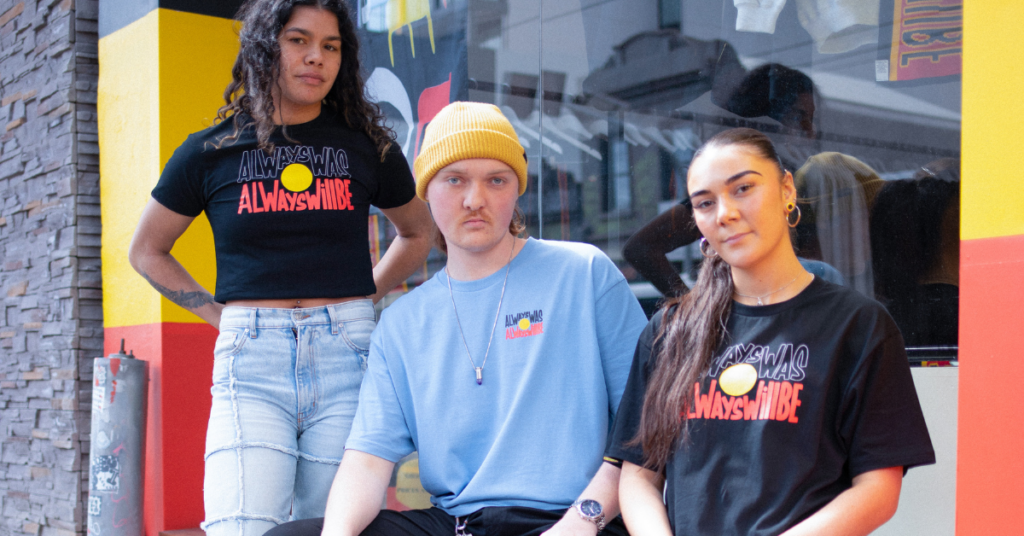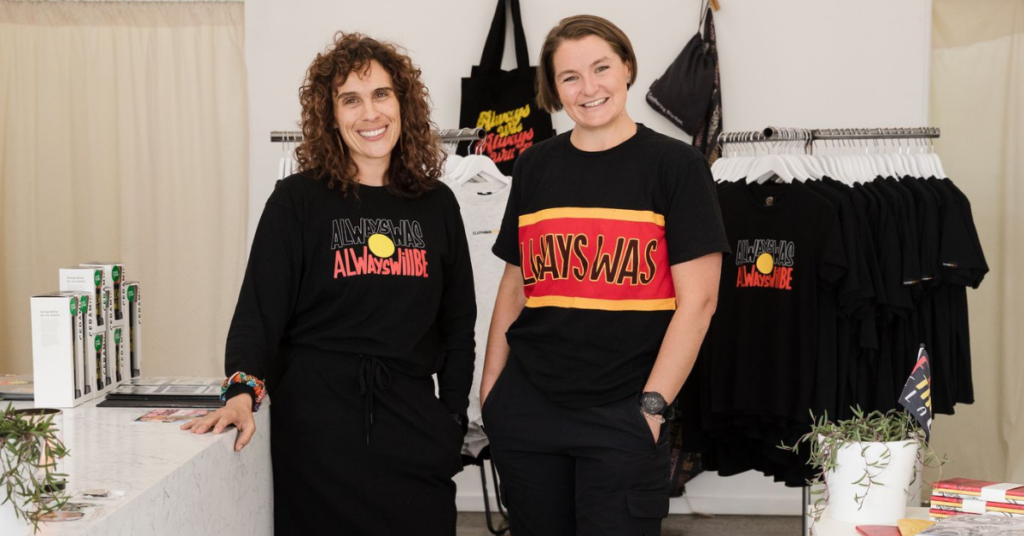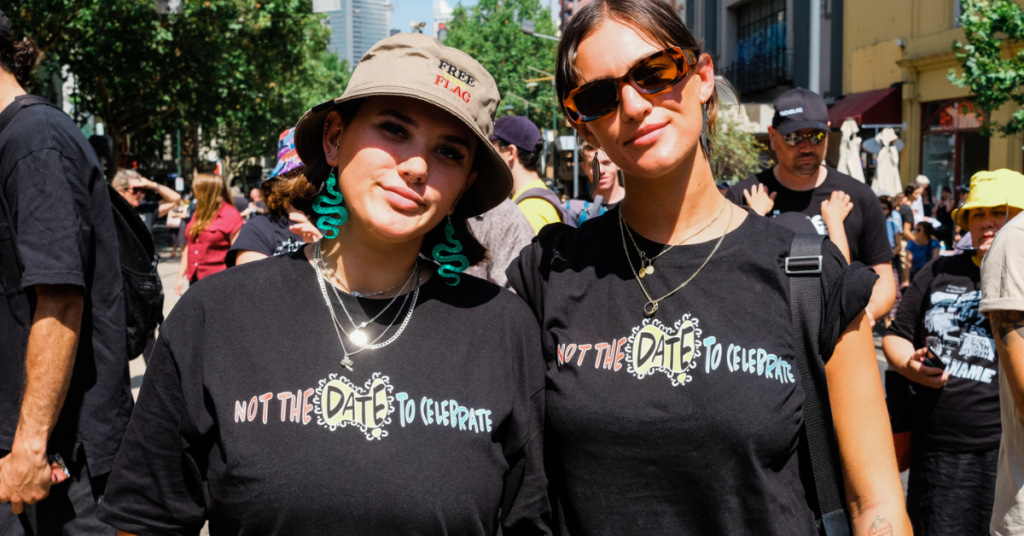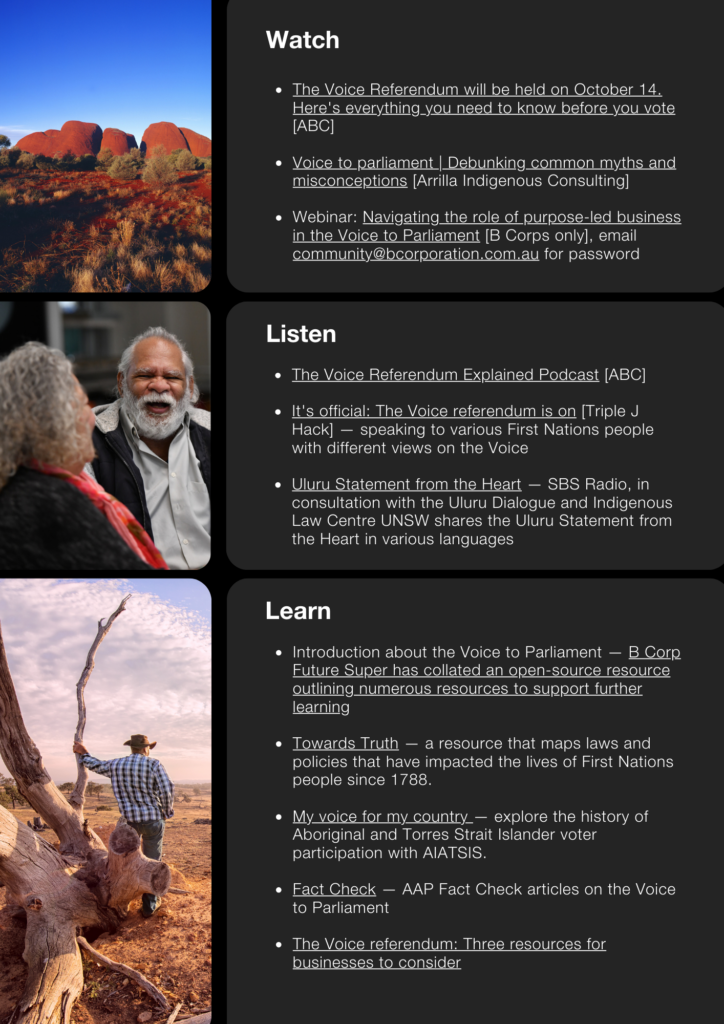What is the role of business in driving and promoting social change? It’s a question at the forefront of many of our minds, not only as we fast approach The Voice Referendum, but as our world and its challenges become increasingly complex and nuanced. While engaging in social issues is not new for business, ultimately, we are seeing businesses across the globe grappling with when, where and how to take a stance on issues of social and environmental systems change, if at all.
As purpose-driven businesses and B Corps, we regularly find ourselves navigating the often fine line between what is personal and what is political. Some might even say that line does not exist.
So, what do we — as businesses — need to bear in mind about our role in systems change work? And more specifically, what can we do as businesses right now in our region to be strong allies in the movement for justice, equity and recognition for First Nations people?

Image by Clothing The Gaps
Following a recent B Corp roundtable, majority Aboriginal-owned business and streetwear company, Clothing The Gaps, had these five things to share on how to use your business to promote social change ahead of the Referendum and beyond.
1. Create space for collective action
We spend a significant portion of our lives at work, and as such, they are key sites of both information and influence. In fact, the evidence shows that businesses are more trusted than governments, the media and even NGOs.
With that trust comes a growing responsibility and demand to engage on issues that are important to our stakeholders, with silence often being an untenable choice.
“When you think about the circle of influence that you all have, you literally have a captive audience [in your workplace]. If there’s anybody that should be opening your emails, it should be your staff.”
— Sarah Sheridan, Co-founder, Clothing The Gaps
Whether it’s getting together over lunch or carving out dedicated time for conversation and connection, it’s important to reflect on how we can use the influence and resources we have to spark action as a collective.
“In a workplace, you’re part of a collective of people. So, who’s door knocking? Who’s doing what? Having those conversations together really strengthens your confidence in being able to go out and tackle them, and we really encourage you to do that.”
— Sarah Sheridan, Co-founder, Clothing The Gaps

Image: Laura Thompson (Gunditjmara) CEO & Co-founder and Sarah Sheridan, Deputy CEO & Co-founder, Clothing The Gaps
Five ways businesses can step up and show up for First Nations people ↗
2. Be visible in your support
Taking a visible stance enhances public perception and builds loyalty among customers and communities; a way of ‘putting your money where your values are’. Beyond the moral imperative, we are also seeing companies that do good being rewarded for it through greater impact investment and more sustainable and inclusive growth.
However, there’s another key reason that being visible in your support for social and environmental issues can be so effective in rallying support for a cause or campaign, according to Clothing The Gaps. Following the success of the Free(d) the Flag campaign, the team realised that “a little bit of FOMO goes a long way”. It turns out that the ‘fear of missing out’ can be a powerful tool for motivating the masses because: “people don’t want to be the only person not saying anything”.
“Think back to the Marriage Equality Plebiscite and it was the visibility, that colour and movement that we saw. I sit here and I think about all the other things those same businesses might have done in the past, like post a Black Square with a corporate social responsibility message and Reconciliation Action Plan. Some of them were even promoting NAIDOC products. But this is ‘too hard’. They will do the internal stuff, but they’re not going to do the external stuff. And it feels like we’re running out of time.”
— Laura Thompson (Gunditjmara), Clothing The Gaps
Whether it’s pinning your Instagram posts to the top of your profile or posting about it regularly, Clothing The Gaps encourages us to use the mechanisms of each platform to keep your messages of solidarity front and centre. “Don’t let it travel down your feed, keep it pinned to the top,” shares Co-founder Sarah Sheridan. While internal advocacy is important, you can’t beat visibility when it comes to taking a stance on important issues.

Image by Clothing The Gaps
3. Acknowledge your privilege, and don’t let racism thrive
In reflecting on the role of businesses in driving and promoting social change, we must also reflect on the critical role of business in helping people take care of themselves, particularly during times of public debate.
Part of leading a more inclusive and kind economy is carefully considering the potential effects of The Voice Referendum on various stakeholders and their sense of psychological safety. It’s also important to acknowledge that the choice to ‘sit on the sidelines’ is not an option, at least not for everyone.
“It is a privilege to choose when and how to show up in support of First Nations justice, one that is not afforded to First Nations people.”
— Laura Thompson (Gunditjmara), Clothing The Gaps
Choosing not to say anything publicly is a way of exercising privilege, and “in deciding not to speak up and use your platform,” businesses are missing a generational opportunity to say ‘yes’ to “recognising, listening and better outcomes for First Nations people”; an opportunity to “walk with us” at a time when “history is calling”.
The quote made famous by Bill Bernbach bears repeating here, that ‘a principle is not a principle until it costs you something’. And so if you are going to take a stance, Clothing The Gaps has these words of wisdom for you:
“If you are going to post anything you must moderate your social media. If you don’t have the resources to moderate your socials, just turn your comments off. That’s fine. Just don’t let racism live in the comments. It’s not okay.”
— Sarah Sheridan, Co-founder, Clothing The Gaps

Image by Clothing The Gaps
Tackling the unfinished business of reconciliation ↗
4. Share existing resources to a broader audience
Already, across the B Corp movement in Australia, we have seen various businesses taking a vocal position on the Voice, in line with their values and actions towards reconciliation. But if you are wondering what more you can do, there is no need to reinvent the wheel.
“If there’s anybody sitting there going: ‘oh, I’ve been wondering if it’s okay if I re-share any of Clothing The Gaps resources or podcasts or social tiles at the moment’ — this is your absolute blanket permission to go for it. Just credit us. You’ve got a reach of people that we may not necessarily have, which is amazing.”
— Sarah Sheridan, Co-founder, Clothing The Gaps
Each of us has our own sphere of influence, our own community, and each business has its own audience. Maybe you’re a writer. A photographer. An organiser. A graphic designer. Maybe you have social influence. Maybe you have a large audience. Or maybe your workplace holds influence. Think deeply about how you can utilise and leverage these experiences and positions for the better.
Sharing reliable, high-quality and factual resources from trusted sources is a way to get existing resources in front of people who might be yet to see them, and it is this content “that’s really starting to help people shift their thinking,” according to Clothing The Gaps.


Download B Lab’s free Voice to Parliament Resource Pack ↗
5. Cast your vote for the kind of world you want to live in
It’s often said that spending money is like casting a vote for the kind of world you want to live in. And October also happens to be Indigenous Business Month in Australia — a time to celebrate the talent and depth of Aboriginal and Torres Strait Islander entrepreneurs from across the business world.
At the recent roundtable, Clothing The Gaps Co-founder and proud Gunditjmara woman, Laura Thompson shared:
“We hear a lot of things about self-determination when it comes to First Nations people, but I can tell you that I’ve never felt more self-determined than when I’m running my own business.”
Business has the power to promote self-determination and create positive outcomes for First Nations communities. When you #BuyBlak you are supporting Aboriginal and Torres Strait Islander peoples and businesses, and helping to grow the Indigenous economy.
Though purchasing from First Nations-owned businesses and wearing Indigenous designs alone is “surface-level allyship.” It comes with a greater responsibility than that; to learn more and do more to dismantle a system that oppresses Indigenous peoples.
It’s on each of us to find meaningful ways to redistribute opportunities, and create space for greater inclusion, representation, recognition and reconciliation. Every conversation, every action, counts right now.

Image taken from Clothing The Gaps Instagram page
A big thank you to Clothing The Gaps for sharing so generously at our recent roundtable event, and for the work they do to support First Nations justice, truth-telling and healing. If you would like to learn more about their work, head to: clothingthegaps.com.au, check out their NAIDOC Week 2024 collection and blogs including why they separated the 2024 NAIDOC Week theme and why ‘C’ is removed from Blak. Be sure to keep up to date with Clothing The Gaps on Instagram @clothingthegaps.
READ NEXT: Tackling the unfinished business of reconciliation – how B Corps can be a voice for generations

